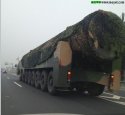* * * * SECRET * * * *
NAIC-1442-0629-97 ( 10 December )
Table of Contents Next Section Feedback
__________________________________________________ _______
Summary
(U) China has designed an upper rocket stage called the ''Smart Dispenser" (SD) for a new space launch vehicle, derived from the CZ-2C, for the purpose of accurate and simultaneous deployment in orbit of two US-made Iridium mobile-telecommunications satellites. China currently has contracts for six such launches plus options for five more. A demonstration launch is currently planned for early 1997.
(U) The technology built into the SD stage has many potential uses beyond the Iridium mission. The SD stage will contain its own solid- and liquid-propulsion systems, avionics (including a guidance system), and telemetry systems which will provide the Chinese with new on-orbit maneuvering capabilities not previously available with past Chinese space launch vehicles.
(S) An initial NAIC study determined that a minimally-modified SD stage could be used on a ballistic missile as a multiple-reentry vehicle post-boost vehicle (PBV) but it would have poor capability in terms of its crossrange and downrange footprint. However, the stage could be developed into a credible PBV with a few relatively minor changes. Thus, the SD stage can be considered a "technology bridge" to a viable PBV. The same could be said for an orbital rendezvous platform for future manned missions or a co-orbital anti-satellite payload.
(C) The new space launch vehicle that will use the SD stage for launching Iridium satellites is currently called the CZ-2C/SD. Although all current Chinese launch vehicles use related technologies and sub-systems, the Iridium CZ-2C/SD launch vehicle is effectively a new launch vehicle, significantly modified from the original CZ-2C. Major differences include upgraded first and second-stage engines, a stretched second stage, an additional third stage (the SD stage), modified equipment bay, and a new fairing. The same designator was possibly kept in order for China to claim the reliability statistics of the CZ-2C.
__________________________________________________ _______
Table of Contents Next Section Feedback
* * * * SECRET * * * *
(S) An assessment was done on the SD stage to determine its viability for use as low performance post-boost vehicle (PBV) on the Mod CSS-4 ICBM. This effort was to assess the PBV performance of the SD stage with a minimum number of modifications. There is no data, whatsoever, that the Chinese have embarked on the development of a PBV based on the SD stage. This is simply an initial determination of feasibility. To date, the Chinese have expressed an interest in developing a multiple reentry vehicle capability that a PBV would provide, however, no known testing of such a system has occurred .
(S) The overall conclusion of this initial feasibility study shows that a minimally modified SD stage could be used to deploy multiple reentry vehicles (RVs). However, when compared to U.S. or Russian PBVs, it would be one of the least capable in terms of its crossrange and downrange footprint. However, with a few relatively minor changes beyond the ones mentioned below, the SD could easily become a credible PBV. Thus, it is concluded that the SD stage can be considered a "technology bridge" to a viable PRV.
(S) The following assumptions were made to constrain the SD-stage modifications. First, only the minimum number of changes would be allowed to the stage to get the job done. The system would not be needed for range extension since the missiles which would most likely use this system, the Mod CSS-4 and the DF-41, would have sufficient range already. The system would deploy three 470-kg Dong Feng 31 (DF-31) RVs. The system would not contain penetration aids (penaids). In addition, all 12 pitch/yaw thrusters would be used for axial thrust. Furthermore, it was assumed that these 70 N thrusters could withstand the full 128 second continuous burn. Additionally, the modified SD stage would have 20 degree/second rotation and turn rate. Lastly, the payload shroud would have a mass of about 200 kg and would be jettisoned early during second stage burn.
(S) Three modifications were identified, two significant and one minor. First, the 163-kg solid propellant kick stage was removed because of the no-range-extension assumption. Secondly, the six pitch and six yaw thrusters were rotated through 180 degrees to turn the PBV into a tractor system, minimizing the amount of fuel required for the deployment maneuvers. Lastly, the 15-kg thermal control system was removed. The masses of the conceptual PBV are shown in Table 3.
Table 3.
Modified SD PBV Mass Breakout (U)
------------------------------------------
Parameter Value
------------------------------------------
Structure (Incl 3 RV ejectors) 260 kg
Guidance System 90 kg
Telemetry & Tracking System 40 kg
Attitude Control System (ACS,total) 80 kg
ACS (Dry) 28 kg
ACS Total Loaded Propellant 52 kg
Other 60 kg
Total 530 kg
------------------------------------------
Secret
(S) A deployment scenario similar to that of the SS-19 Mod 3 PBV was used as it is relatively simple and effective. The RVs are evenly spaced on the PBV deck and mounted a triangular pattern. After booster burn-out, the PBV would rotate to the first null-range axis (NRA) or 180 degrees if a range extension is required. After rotation, the PBV would begin thrusting up the NRA. After a brief settling period, the first RV is deployed. The PBV would then continue to fly along the NRA (away from the just-separated RV) for three seconds. Next, the PBV would rotate and fly to the next .



















